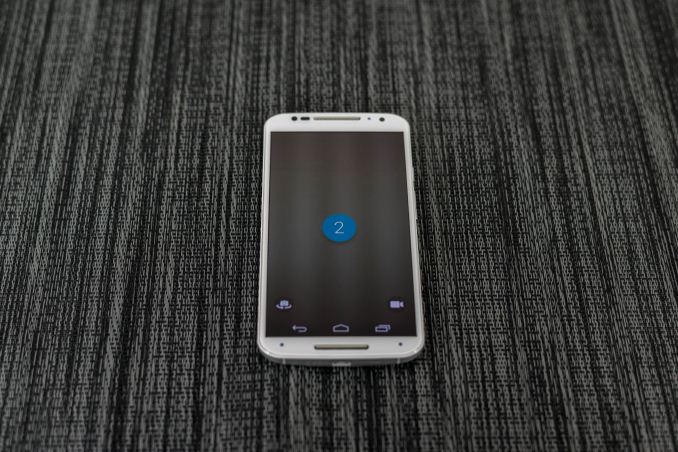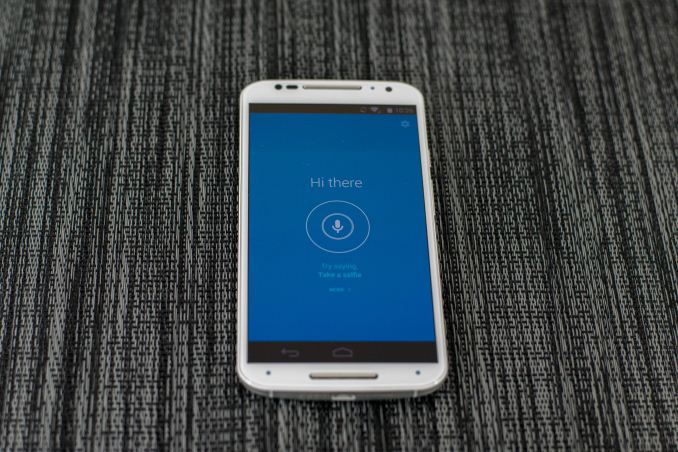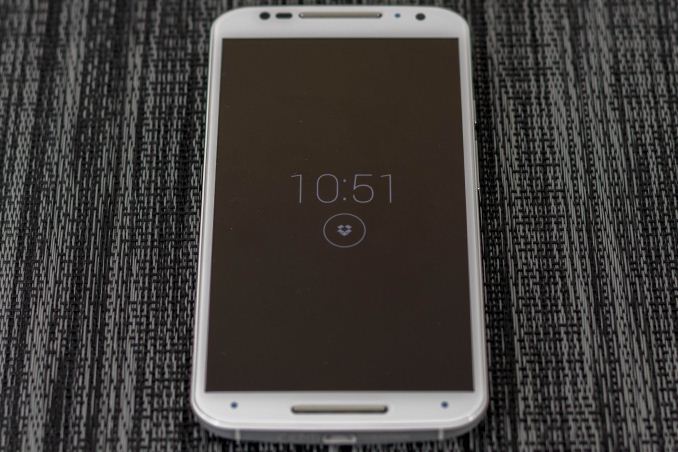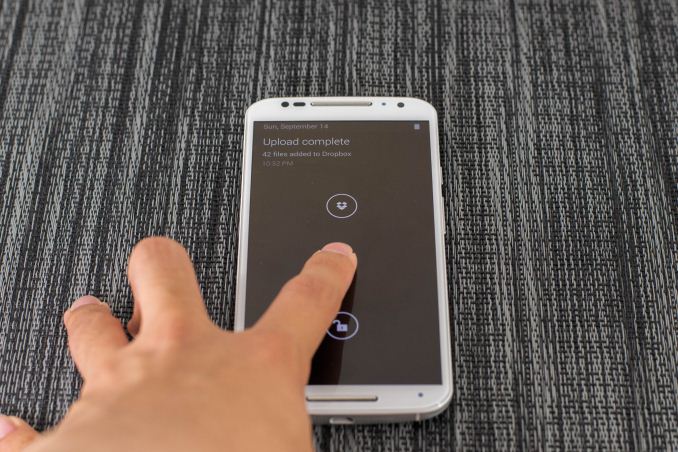The New Motorola Moto X (2nd Gen) Review
by Joshua Ho on September 17, 2014 9:00 AM EST- Posted in
- Smartphones
- Motorola
- Android
- Mobile
Moto Voice
One of the highlight features of the previous Moto X was Touchless Control, and Motorola spent a great deal of time trying to empahsize improvements in this feature with at the launch event. For those unfamiliar with Touchless Control in the previous Moto X, I would reference Brian's Moto X review. For those that don't want to read another review, the quick explanation is that Moto Voice acts as a voice command system, similar to Siri but with integration into Google Now and it works purely based on voice instead of long pressing a home button or a swipe gesture on the navigation keys. With the new Moto X, not too much changes, but there are some key features added. First, we see the ability to assign new keywords other than “Ok Google Now”, which is nice. I’m not really sure how this is enabled, as based upon some digging Motorola is still using a TI C55x DSP to enable low power hotword detection.
For the most part, other than this change I don’t really see a major step forward in functionality, although I’m sure that some will see a great deal of benefit from the voice-enabled selfie feature, which automatically opens the camera app with the countdown as seen above. Voice control continues to be an area where I’m unsure that there’s functionality to be had all the time. For the most part, I only seem to use voice control in situations where my hands are unable to manipulate the phone, which basically means when I’m driving or walking. For better or worse though, this is an area where wearables are much more effective. For example, it’s quick and easy to raise my wrist and ask for navigation to an event while driving compared to trying to reach into my pocket and carefully pull out my phone without dropping it under the seat. While explaining how this happens is a long story, the critical point here is that Moto Voice doesn’t really have a killer use case that isn’t done better by something else.
At any rate, the user interface also changes with the new Moto X. We see a great deal more color and a generally friendlier UI compared to the rather dark theme we saw before. Motorola seems to be following Android UI trends in general with this move, although it will affect battery life on AMOLED panels. The setup process is relatively simple, although there’s definitely a need for a quiet room. Even mild amounts of background noise will complicate setup. I also noticed that differing aural environments could alter the responsiveness of Moto Voice, although this could be due to the function turning itself on and off due to a bug in the ROM.
Moto Display
While Moto Voice is a bit limited in usability, Moto Display continues to be a great feature. For those that are unfamiliar with how Active Display worked in the previous Moto X, I would reference Brian's Moto X review again. For those that aren't familiar with Moto Display, this is effectively a low power mode in the Moto X that will display notifications and the time that also acts as a lockscreen. In order to support this low power mode, it isn't actually a part of Android OS and is programmed by a microcontroller so it isn't possible to take a screenshot of Moto Display.
While what we saw in the original Moto X was fantastic, the new Moto X takes things further by adding Moto Actions. While one part of Moto Actions is waving to silence alarms and phone calls, the other aspect allows for proximity to turn on Moto Display. This means that there’s no longer a need to shake the table or wiggle the phone in order to glance at notifications. While the original Moto X had a similar feature, it relied on the proximity sensor and required precise hand placement in order to turn on the display. Instead, with the new Moto X all that is needed is a hand wave or just getting close to the phone. It doesn’t really need to be accurate either, as pretty much any hand wave over the display will cause Moto Display to activate. In practice, handling of the notifications is still mostly similar, although now there’s the ability to display up to three notifications instead of just one.
While Active Display in the original Moto X was good, the new Moto X really turns it into a fantastic feature. It's hard to really explain because on the surface it seems rather mundane but after using Moto Display it's clear just how much time it saves. The glance time is just right to view notifications and the hand wave/approach action is effortless compared to pressing a home button or tapping the display. There's also no doubt that this helps to improve real world battery life as the seconds used to glance at notifications adds up quickly over time, especially because initial unlock will drive the CPUs to max power to ensure responsiveness.
If I’m honest, I’m not really completely sure how this new feature is implemented either. TI’s MSP430 is gone, and the part that seems to take its place is an STM401 sensor processor, which could be the solution used to enable Moto Display and also acts as a sensor hub. I'm not really sure what drove a change, but it's possible that the MSP430 limited feature expansion.














179 Comments
View All Comments
cknobman - Wednesday, September 17, 2014 - link
Hmmm.........Crap screen
Crap battery life
Crap camera
Why should anyone buy this again?
piroroadkill - Wednesday, September 17, 2014 - link
They won't.There were reasons to buy Moto X, but this new version is pointless, it's huge and worse than the alternatives.
soccerballtux - Thursday, September 18, 2014 - link
I don't understand what the hate is. I still think it's a great phone.gg555 - Wednesday, September 24, 2014 - link
I'd say it has a very good, but not top of the line screen. A passable camera. And okay battery life (bettery than many of last years phones), but again not top of the line for today's flagships. So your characterizations are unfair, I think.The Moto X does have a beautiful design, arguably one of the best out there, on a Par with the HTC One M8. It also has the active display, always on voice commands, and the hand gestures, which sound like they are very well developed features that add convenience (unlike the gimmicky heartrate crap on other phones).
It has basically stock Android, without a bunch of bloat software, which many people like. And this will also make it easy for it to get very quick updates to new version of the OS (all of Motorola's additions are downloadable as apps and do not require Motorola to spend a lot of time updating its skin, etc., for a new version of Android).
It also as a super sophisticated antenna design, as explained in the AnandTech preview of the phone a couple weeks ago. That ought to make it industry leading, if you know, you use your phone to connect to a network.
And it has a once of a kind four microphone noise cancellation solution. This is extremely unusual. The best noise cancellation chip out their (from Audience) has a three microphone option, but don't know of anyone who has even implemented that (if so it's very rare). Two microphones is the norm. So four microphones is exception. Unfortunately, AnandTech did not test it like they used to do. But it could make for incredible call clarity in noisy settings.
So the Moto X is certainly not necessarily for everyone. There are arguments to be made for other phones. But I think it holds it own, offers useable features, rather than gimmicks, and has a lower price than other flagships. It's a prefectly good choice. Other phones have their own shortcomings.
DeciusStrabo - Wednesday, September 17, 2014 - link
Man, that's sad to see all these regressions. I love my Moto X, could easily deal with the increased size and love to see the performance, but that battery life is simply embarassing. Worse than last years version? That's simply not acceptable. Worse screen in some respects and a camera that's somewhat better, but not really good doesn't help.I really was very close to ordering the new Moto X, but it seems I will have to wait at least until the new Nexus device, maybe even longer. Or - god forbid - think about an iPhone.
semo - Wednesday, September 17, 2014 - link
In this day and age, regression sells! I have no idea how but putting taking useful features away somehow generates more sales. It's also another chance to (re)introduce groundbreaking and amazing features at a later date!I think these days, if you are a phone manufacturer, all you have to do is make the screen bigger and you can take a massive dump on anything else. Better still, if you are a monitor manufacturer, just stick an LTE chip to one of your monitors and sell it as the best phone ever.
MrGutts - Wednesday, September 17, 2014 - link
Not to be a smart ass; well yeah I am going to be.Why in the world does someone want to invest money in a company that gets pass around like some prostitute on Saturday night? Who's turn is it this year, IBM was it?
The company doesn't communicate anything to the consumers, they horribly screwed a ton of customers on new phones telling them they are NOT upgrading the android OS on the phones. The list can go on with them.
DeciusStrabo - Wednesday, September 17, 2014 - link
Which phones don't get an update by Motorola?soccerballtux - Thursday, September 18, 2014 - link
The Atrix4G was marketed as the worlds most powerful phone, and never made it past Gingerbread even with its 1GB RAM and dual core processor.I still hate them for it
randomlinh - Wednesday, September 17, 2014 - link
Hrm, no T-Mobile LTE band 12... which is the newly acquired 700mhz VZW band I believe? Though, almost moot given how disappointing the battery life is.